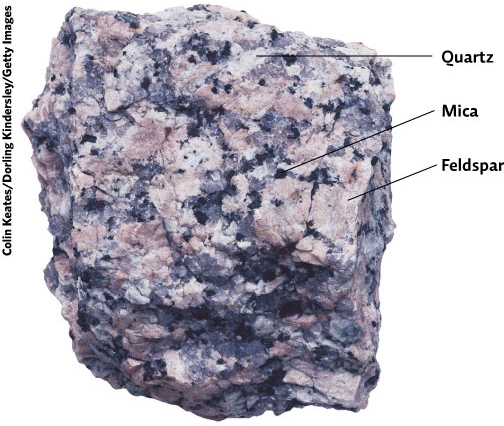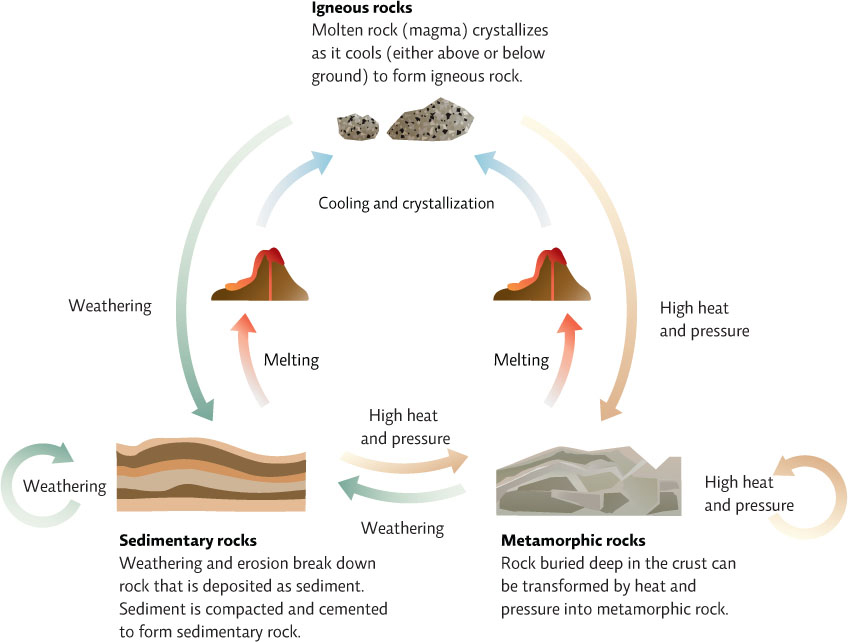Geologic processes produce mineral resources.
Minerals are naturally occurring solid compounds with a definite crystalline structure and specific chemical composition. They include both metals (like gold, silver, indium, and the rare earths) and nonmetals (like quartz and rock salt) and are classified according to several physical properties, such as hardness and luster, that arise from their chemical composition and structure. To make use of minerals—to find large deposits that we can mine, or to design synthetic compounds with similar properties—we must first understand their basic geology, starting with the forces that create them.
geology
The study of the structure of Earth and the processes that have shaped it in the past and shape it today.
KEY CONCEPT 26.2
Mineral resources are produced, transformed, and moved around by geologic forces over long time frames.
Earth is composed of discrete layers of solid and molten rock. The part we mine is the lithosphere, which is composed of Earth’s solid upper crust and the uppermost portion of the mantle. The lithosphere is broken into tectonic plates that float above the asthenosphere—a layer of hot, weak rock in the upper mantle that flows slowly and responds to the pressure exerted on it (like putty or molding clay). As molten rock (magma) is forced up from the asthenosphere through plate boundaries (places where edges of tectonic plates meet), the plates themselves move, carrying the continents across the face of the planet as they go—ripping them apart and shoving them together over eons, releasing colossal amounts of energy in the process. INFOGRAPHIC 26.2
tectonic plates
Sections of Earth’s crust that float above the magma layer.
EARTH—A DYNAMIC PLANET
Earth is composed of discrete layers. The crust, mantle, and core are distinguished by their distinct chemical composition; regions within these layers that have different physical properties are also recognized. Mineral and fossil fuel deposits are found in the layers of Earth’s crust. Powerful geologic forces are constantly but slowly rearranging the face of Earth.
The crust is made up of tectonic plates that move slowly, powered by the heat of the innermost parts of Earth. This process changes the face of Earth. It also forms new minerals and redistributes others within Earth’s crust. The location of earthquakes and volcanoes gives clues about the location of plate boundaries, representing places where plates move against one another or spread apart to release magma from the top part of the asthenosphere.


What allows Earth‘s crust to move above the mantle, resulting in a change in its shape and causing earthquakes?
The bottom part of the crust, the lithosphere, is not one solid layer but instead is broken into several plates that rest on top of the liquid magma layer directly below (the asthenosphere). The plates move independently of one another and sometimes move apart (creating trenches) or move together (raising the crust as one plate subducts (goes below) the other, sometimes causing earthquakes).
26-7
KEY CONCEPT 26.3
Minerals are finite resources, and we are tapping some reserves very quickly; more extreme extraction measures will be needed as these reserves dwindle.
It is through these processes—through the movement of plates and the release of energy, along with the activity of air and water, that minerals are created. Under such extraordinary heat and pressure, atoms of naturally occurring elements combine to form new compounds, many of which are stable enough to endure for eons. The relative abundance and assortment of elements in any given location determine which chemical reactions will be favored and, thus, which compounds will form. Because of this, minerals are not distributed evenly throughout the planet’s lithosphere; different minerals are abundant or uncommon in different parts of Earth.
Mineral deposits are almost always found as a component of rock. In fact, for the most part, rocks are conglomerates of minerals—though they occur in a variety of configurations and are constantly formed and transformed via the rock cycle. Igneous rocks form where magma emerges and cools at plate boundaries; metamorphic rocks are those that have been altered from their original solid rock state by the heat from magma or the pressure from moving plates; and sedimentary rocks are created by the pressure that builds as sediments (pulverized rocks, shells, organic detritus) accumulate, piling on top of one another in rivers, streams, and deep basins under the sea. INFOGRAPHIC 26.3
rocks
Conglomerates of one or more minerals that occur in a variety of configurations.
rock cycle
The process in which rock is constantly made and destroyed.
MINERALS, ROCKS, AND THE ROCK CYCLE
Minerals are the building blocks of rocks. If free of any space restrictions when forming, each mineral would exhibit its characteristic crystalline structure. Constrained by the rock, the crystals are smaller, but each discrete mineral is still visible. Rocks may contain a single mineral (such as rock salt, NaCl) or more than one, such as this granite rock that contains three minerals.

THE ROCK CYCLE CONSTANTLY FORMS AND RE-FORMS ROCKS IN EARTH’S CRUST
Rocks form and are transformed when they are subjected to high heat and pressure underground and when they are exposed to wind and water on Earth’s surface.


Distinguish between a rock and a mineral.
A mineral is a naturally occurring chemical compound that exists as a solid with a predictable, three-dimensional, repeating structure. A rock is a conglomeration of one or more minerals. In other words, minerals are the building blocks of rocks.
26-8
Minerals are most often found as components of rocks. Ores are rock deposits that contain economically valuable amounts of metal minerals; this means not only do the minerals within have practical applications, but they are also concentrated enough to be worth the effort of mining and extracting them. Minerals are considered nonrenewable resources. Yes, they form naturally through the aforementioned Earth processes, but we are using up existing deposits faster than new ones are being created. As with many of Earth’s resources, the vast majority of mineral use has occurred in recent decades. In fact, of all of the minerals used in the 20th century, more than half were used between 1975 and 2000; according to one recent study, only 2.5% of all the copper ever mined was used before 1900.
ore
A rock deposit that contains economically valuable amounts of metal minerals.
mining
The extraction of natural resources from the ground.
Geologists are not sure how long reserves of any given mineral might last; a mind-boggling array of ever-changing factors must be taken into consideration, and past estimates have been notoriously off. (For example, some groups predicted that indium reserves would dry up by 2000, a date that has since been pushed back to 2020.) The consensus seems to be that for the most important minerals, existing supplies are still orders of magnitude greater than current usage. But not all reserves are created equal: Mining some will be much more environmentally taxing than mining others.
“The real question is not ‘do we have enough,’” says Caltech geologist George Rossman. “But rather ‘how far are we willing to go to access what we know is there?’”